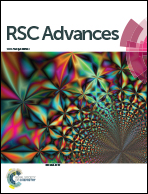Fluorescent chemodosimeter based on spirobenzopyran for organophosphorus nerve agent mimics (DCP)†
Abstract
A new chromogenic as well as fluorogenic protocol based on the spirobenzopyran system for the selective detection of nerve agent mimics (diethyl chlorophosphate or DCP vapour) within a few seconds (∼30 s) is designed, synthesized and characterized in this study. The nucleophilic attack from the oxygen atom of the spiro ring on the electrophilic phosphonyl group of DCP (diethyl chlorophosphate) causes the opening of the spiro (SP) framework and ultimately gives rise to the meta stable merocyanine (MC) form to give a fluorescent species, which gives a signal in the red region (∼675 nm). The ‘turn-on’ red fluorescence and a colorimetric change from colourless to yellow was observed upon the addition of DCP, which evokes almost 124 and 84 fold enhancement in the absorbance and emission intensity, respectively, compare to the probe itself. To the best of our knowledge, such a DCP sensor based on the spirobenzopyran network has not been reported to date. Moreover, the detection limit of this probe was found to be in 10−8 M level in the solution phase. We also developed it as a portable chemosensor kit for DCP and demonstrated its practical application in real-time monitoring.


 Please wait while we load your content...
Please wait while we load your content...